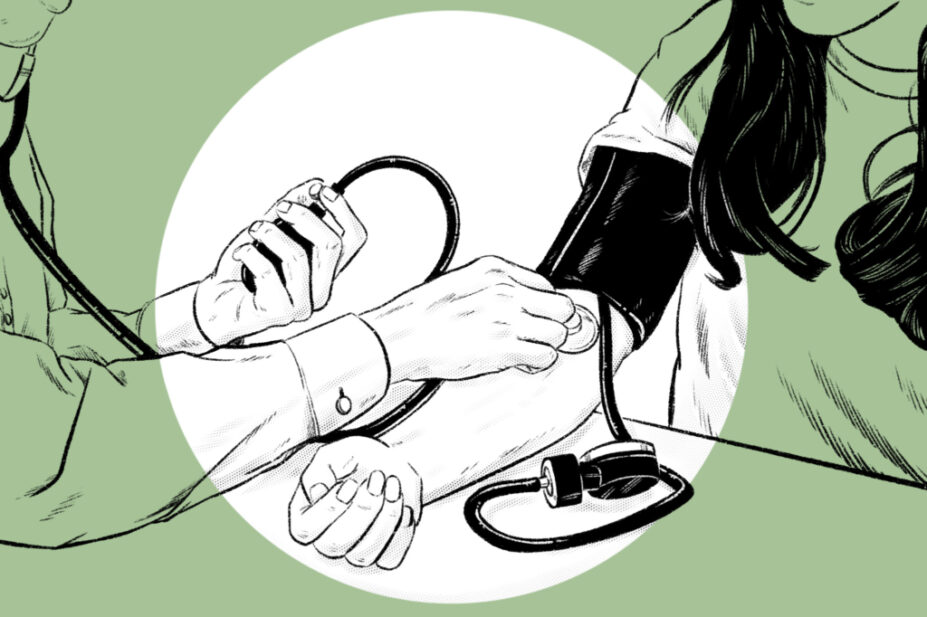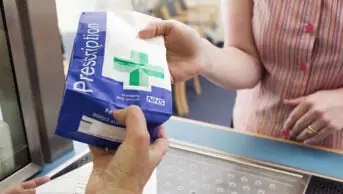
Wes Mountain/The Pharmaceutical Journal
By the end of this article, you will be able to:
- Identify commonly used assessment tools for acute and long-term care;
- Understand the role of scoring systems for the diagnosis of certain conditions;
- Use tools to recognise acutely unwell or deteriorating patients.

RPS Competency Framework for all prescribers
This article aims to support the development of knowledge and skills related to the following consultation domains:
Domain 1: Assess the patient (1.2, 1.7)
- Considers patient dignity, capacity, consent and confidentiality;
- Undertakes and documents an appropriate clinical assessment.
Domain 4: Prescribe (4.13)
- Documents accurate, legible and contemporaneous clinical records.
Introduction
Clinical assessment is a process of collecting information about a person’s health status, function and wellbeing. It involves using a variety of techniques, including observations, tests, assessment tools or physical assessments, to create a series of findings that either identify an abnormality or inform differential diagnosis[1–3].
There are many variables that determine the type of clinical assessment required, including the clinical setting, acuity of the patient, and whether the health need of the person is a mental or physical concern.
Pharmacists undertake a variety of roles, with many requiring the use of physical assessment skills, often related to their scope of prescribing practice and defined responsibilities. However, in all contexts, prescribers have a responsibility to recognise when a patient is acutely unwell or at risk of rapid deterioration in their physical or mental health. This article will focus on undertaking an appropriate assessment for these scenarios.
It is recommended that you read this article in conjunction with these resources from The Pharmaceutical Journal:
- Introduction to the prescribing consultation;
- Principles of effective history taking when prescribing;
- Principles of person-centred practice for prescribing;
- How to use clinical reasoning in pharmacy
- How to build and maintain trust with patients.
To help further expand your prescribing skills, additional related articles are linked throughout. You will also be able to test your knowledge by completing a short quiz at the end of the article.
Identifying appropriate assessment approaches
Clinical and physical assessments often follow the completion of a thorough clinical history. The information gained from the history will guide the development of the differential diagnosis and influence the approach to subsequent assessments[4]. A focused assessment may be completed if the history indicated a specific issue or the patient is being reviewed for a known health condition, whereas a general assessment may be required if the presentation is unclear, urgent or emergent, or if you are not familiar with the patient[2].
Clinical assessments should be undertaken in an appropriate environment for the setting in which you are working and the condition the patient is seeking support for; this could be a designated consulting room, a quiet area of the pharmacy, or behind the closed curtains of a patient’s ward bed space.
The general assessment of a patient begins the moment you make contact with them, observing how they appear, their gait and ability to converse and interact with you. These elements all provide information to you about their health. From this initial review, you will need to determine what type of assessment is required next.
There are a variety of tools and approaches that prescribers can draw from when conducting a patient assessment. A selection of some of the most commonly used tools in clinical practice are summarised below.
ABCDE assessments
The ABCDE (airway, breathing, circulation, disability, exposure) assessment is a well established and structured approach for assessing patients in emergency situations or when faced with an uncertain acute scenario[5–7]. Its purpose is to identify and manage the patient’s most life-threatening issues first. The steps may be repeated at regular intervals to monitor the progress of the patient over time. It is increasingly utilised within primary and secondary care settings as an effective method for assessing a patient’s baseline health status, identifying unstable patients or individuals at risk of deterioration and for reducing mortality in hospitals[8,9].
Airway
First, the airway (noise, mouth, larynx, pharynx, trachea, bronchi and bronchioles) should be assessed to ensure that it is able to fulfil the function of carrying air to the lungs. You will be observing to identify if there is an obstruction or potential obstruction. A reassuring feature of a stable airway is if the patient can talk normally in full sentences[7].
In partial obstruction, there may be reduced air entry, which alters the breath sounds; for example, wheezes and whistles. The type of noise may guide the source and location of the obstruction and support the diagnosis. Gurgling usually indicates fluid in the mouth or upper airway, potentially from secretions or vomit. Inspiratory stridor (high-pitched sound) is indicative of partial upper airway obstruction, which may result from the presence of a foreign body, inflammation or oedema. This could be owing to laryngeal inflammation and forms part of the ‘red flag’ review for sore throat. An expiratory wheeze is more commonly recognised as a symptom of narrowed bronchi and bronchioles, as observed in chronic airway conditions, such as asthma and COPD[3].
Focus in practice: Airway assessment
To hear examples of airway noises, watch this short video produced by Geeky Medics.
In full obstruction, there will be no breath sounds, with other signs, including paradoxical chest and abdominal movements and/or the later sign of cyanosis (blue coloration) of the mouth and lips. Decreased levels of consciousness may also be observed[3].
Breathing
Assessment of breathing is distinct from the review of the airway and is focused on the effectiveness of the gaseous exchange. Consequently, you are observing for signs of respiratory distress, including signs or symptoms outside the normal respiratory parameters of talking comfortably, respiratory rate of 12–20 breaths per minute (bpm) and an oxygen saturation (SaO2) of 96% or above (unless the patient has a personalised accepted target as part of their COPD plan) or more general symptoms of appearing anxious, sweating and needing to maintain an upright position to breathe.
Concerning signs include the patient being too breathless to talk, a respiratory rate below 12bpm (bradypnoeic) or above 25bpm (tachypnoeic), or SaO2 below 91%. Other indicators of distressed breathing include altered chest expansion (asymmetrical, tracheal deviation, or use of accessory muscles) or the presence of cyanosis.
During the assessment, you should look, feel and listen for changes in breathing. Assess the depth, pattern and quality of the breathing for a cycle of 15 seconds and the respiratory rate for a full minute. Oxygen saturation should be measured using a validated pulse oximeter[10,11].
Circulation
A review of the circulation encompasses a wider review of the circulatory system. The initial observation is a general inspection of the patient’s skin, noting changes in temperature, signs of pallor or cyanosis or obvious signs of trauma, including wounds or presence of significant haematoma.
The next step is assessing the presence, quality, rate and rhythm of the radial pulse. A normal pulse should be regular, strong and bounding. Deviations from this should be investigated as a cause for concern. An indicator of a deteriorating patient would be a thready, almost imperceptible, pulse. The pulse rate should be taken over one minute and be 51–90 beats per minute[10].
Capillary refill time (CRT) can be measured by applying pressure to a fingertip for five seconds and then releasing the pressure and timing how long it takes for the skin blanching to resolve. A good cardiac output gives a CRT of less than two seconds[12].
A blood pressure measurement is a good tool for assessing cardiac function; although, for the purpose of the ABCDE assessment, it is worth noting that the acceptable parameters are different to those recognised for the diagnosis and treatment of hypertension, with an acceptable systolic range of 111–210mmHg as a good indicator of haemodynamic status.
Later signs of reduced cardiac function include reduced urinary output (oliguria) and impaired consciousness.
Disability
The focus of this element of the assessment is on the central nervous system and reviewing the patient’s level of consciousness. Commonly used tools for assessing the level of consciousness include the AVPU scale and Glasgow Coma Scale[13,14].
Focus in practice: AVPU scale
Alert patients can engage freely, whereas a patient that is not fully awake or alert may need an external stimulus, such as a voice command or gentle shaking to evoke a response. These patients are assigned…
V (responds to vocal stimuli). If a patient does not respond to a vocal prompt, they are assessed by gently rubbing the sternum, if the patient responds to this (eye opening, vocal sounds or movement) they are assigned…
P (responds to pain), if the patient has not responded to any of these, they are described as…
Unresponsive.
The cause of the altered state of consciousness will need to be explored and other neurological tests may be required. Note that a change in the patient’s alertness may present as confusion and a separate assessment may be required to ascertain if this is the patient’s baseline or an acute event requiring investigation and treatment, such as hypoglycaemia, stroke or head injury. It is pertinent to complete a blood glucose test as part of this element of the assessment to rule out hypoglycaemia (blood glucose below 4mmol/L).
Exposure
This is a review of the patient’s skin for indicators of disease and serious illness, including observing for rashes (e.g. meningitis, septicaemia, anaphylaxis), wounds, pressure injuries, sites of infection, bruising and haematomas. It is important to approach this assessment in a patient-centred way and protect the patient’s dignity, with particular consideration given to situations where bodily exposure owing to undressing is required. Reassuring features would include a person presenting with no remarkable changes to their skin surface or extremities.
National Early Warning Score
The information garnered from an ABCDE assessment provides the foundation for the National Early Warning Score. The approach uses an aggregated score based on respiratory rate, oxygen saturation, systolic blood pressure, pulse rate, new confusion or level of consciousness, and temperature, recorded on a standardised chart to determine the patients current state, risk of deterioration and when to refer for clinical escalation.
Glasgow Coma Scale
Unlike the AVPU approach, the Glasgow Coma Scale is a standard assessment for level of consciousness that uses a numerical system, allowing for a graded review. This may be useful for indicating smaller changes in consciousness. The patient’s behaviours associated with motor responsiveness, verbal performance and eye opening are independently assessed, with a score of 15 indicating full consciousness, and a score of 3 inferring coma or death[14].
Clinical assessments for minor ailments and less serious conditions
Many prescribing pharmacists will be working in settings where patients present with minor ailments or less serious conditions, and you will need to assess their condition using either an assessment tool, physical assessment or both. An example of how this can be done in relation to sore throat is provided below. For a range of resources on minor ailments, visit The Pharmaceutical Journal‘s minor ailments hub page.
Focus in practice: assessing a sore throat
When patients present with a sore throat, a determination of the severity of the symptoms and the likelihood of the infection being bacterial will influence the management options. When undertaking a physical examination of the throat, you will be observing for the presence or absence of exudate, inflammation, erythema and lymphadenopathy. After undertaking the history and performing a physical assessment, you can apply either the Fever-PAIN or Centor clinical prediction tools to determine the likelihood of bacterial (streptococcal) infection and use this to establish whether antibiotics are indicated[15–17].
In the Fever-PAIN assessment, a score of one is given for each of: fever during the preceding 24 hours; presence of purulence on the tonsils or pharynx; rapid attendance for symptom support (less than three days); severely inflamed tonsils; and no cough or coryza. A score of 1 or below indicates a low risk of streptococcal infection, a score of 4 or higher suggests it is more likely to be a bacterial infection.
The Centor criteria works in a similar way, with a point scored for the presence of tonsillar exudate, lymphadenopathy, fever and absence of cough. A score below 2 indicates it is more likely to be a viral infection and a score of 3–4 is more indicative of bacterial infection. For more on assessment of sore throat, see ‘Case-based learning: sore throat’.
Tools to assess mental health conditions
A mental health assessment should be considered in parallel with physical assessment. While a full mental health assessment is likely to be conducted by a specialist, prescribers should be alert to the risk of common mental health comorbidities, such as depression and anxiety, and consider how the patient’s mental health may intersect with their physical health and influence the subsequent management plan.
Screening tools, interview questions and questionnaires can be used by non-specialists to assess for possible mental health conditions and a management plan. Commonly used screening tools include the Generalised Anxiety Disorder-7 Questionnaire and Patient Health Questionnaire-9 for depression[18,19]. These screening tools utilise a series of questions, with assigned scores to ascertain a person’s current anxiety or depression state, and may be used as part of a general health survey, a focused review or checking response to treatment[20,21].
Another widely used tool is the mini-mental state examination. This is used for assessing the cognitive impairment of older adults, as part of the diagnostic criteria or reviewing progression of known cognitive impairment. The results are commonly used as part of medicines reviews and have greatest value for supporting people living with dementia[22–24]. Full consideration of the mental health assessment procedure is beyond the scope of this article but further reading on the subject has been identified below.
Case in practice
The following case study explores how a prescribing pharmacist can apply some of the assessment approaches introduced in this article to practice. Answer guidance is available at the end of the article.
Patient profile
 Mr Javier, a teacher aged 35 years, presents to your community pharmacy requesting an emergency supply of his salbutamol inhaler to manage his asthma condition. He has been using his inhaler more frequently over the previous 48 hours and, as a result, has run out before his prescription from the GP has been processed.
Mr Javier, a teacher aged 35 years, presents to your community pharmacy requesting an emergency supply of his salbutamol inhaler to manage his asthma condition. He has been using his inhaler more frequently over the previous 48 hours and, as a result, has run out before his prescription from the GP has been processed.
Background
Mr Javier states he has experienced more frequent shortness of breath over the past few days and thinks this is owing to a cough and cold he has caught from the children he teaches. On observation, you can see he is visibly sweating and looks clammy. He is struggling to talk to you in full sentences and you notice his respiratory rate is increased. You also notice a visible tremor in his hands, which he confirms is new for him.
How would you proceed and which clinical assessment tools would you use to guide your assessment?
Answer guidance is available at the end of the article.
Questions for reflection
- This article has considered a general approach to clinical assessment tools. As a prescriber, you are likely to be working in a specific clinical setting and within a defined scope of practice. Which assessment tools most apply to your scope and area of practice? Are there any additional approaches that you might be able to incorporate?
- Consider the referral pathways available to you if you assess a deteriorating patient or patient that presents with red flag symptoms. Are your referral options clear in an emergency scenario?
- Are you regularly accessing feedback on your clinical assessment skills? Consider asking a colleague to observe you undertaking a clinical assessment with a patient, utilising the supervised learning event tools available via the Royal Pharmaceutical Society’s post-registration foundation or core advanced pharmacist curriculum. The mini-clinical evaluation exercise and direct observation of procedural skills assessment tools would be particularly useful to demonstrate and reflect on your practical skills of clinical assessment.

Test your knowledge

Expanding your scope of practice
The following resources expand on the information contained in this article.
- National Early Warning Score (NEWS) , NHS England
- The ABCDE Approach, Resuscitation Council UK
- A to E Assessment for Deteriorating and Acutely Unwell Patients (video), RhesusMedicine
- COPD, Acute Management, ABCDE, Geeky Medics
- Tools for measuring changes in mental health, MIND
Answer guidance for case in practice
Initial approach
Using the ABCDE approach, it is clear that there is concern for A and B and these will form your priority.
Airway: The patient is struggling to speak in full sentences, suggesting severe respiratory distress and a potentially life-threatening situation. Immediate further assessment and response is required. You will also be listening for changes in the breath sounds — either easily audible or through the use of a stethoscope. Audible sounds would likely include a wheeze if there is airway obstruction resulting from his asthma or crackles if using a stethoscope and infection is present.
Breathing: This is the broader review of how effective breathing is. The raised respiratory rate is an indicator of distress.
Circulation: To assess circulation, you will be looking for any signs of cyanosis, including changes in capillary refill time, blue lips and changes in skin pallor.
Disability: The patient is conscious and conversing with you; therefore, the patient would be assessed as alert using the APVU scale and at this stage is not a concern. However, it would be useful to monitor the patient for changes.
Exposure: The patient appears clammy.
The application of ABCDE has identified symptoms that are potentially serious and these should be investigated further to identify the cause by taking a detailed history and forming a differential diagnosis.
Further follow-up questions could include:
- How long has the shortness of breath been present?
- Are there any other symptoms?
- Is there any chest pain or pain on inspiration?
- Is the tremor new?
Likely diagnosis
The likely diagnosis is a chest infection, based on the perceived infection markers, which in this case include an increased temperature and fever associated with the shortness of breath and increased salbutamol usage.
Action taken
Supply the patient with an inhaler to help with immediate shortness of breath and signpost to his GP, or walk-in centre if the surgery is closed.
If the prescriber is competent, they could undertake the appropriate assessments: assess his chest and take observations, such as temperature, oxygen saturation, blood pressure and pulse, to help determine the severity of the infection and rule out another cause. If this form of assessment is outside the scope of practice, the prescriber should signpost the patient to an appropriate service where this can be provided.
- 1Carlson J. Clinical Assessment. In: Friedman H, ed. Encyclopaedia of Mental Health. Academic Press 2016:293–296.
- 2Baid H. The process of conducting a physical assessment: a nursing perspective. Br J Nurs. 2006;15:710–4. https://doi.org/10.12968/bjon.2006.15.13.21482
- 3Szilagyi P. Bates’ guide to physical examination and history taking. 13th ed. Phildadelphia, United States: Wolters Kluwer 2021.
- 4Price CI, Han SW, Rutherford IA. Advanced nursing practice: an introduction to physical assessment. Br J Nurs. 2000;9:2292–6. https://doi.org/10.12968/bjon.2000.9.22.5416
- 5Smith D, Bowden T. Using the ABCDE approach to assess the deteriorating patient. Nursing Standard. 2017;32:51–63. https://doi.org/10.7748/ns.2017.e11030
- 6Soltan M, Kim M. The ABCDE approach explained. BMJ. 2016;i4512. https://doi.org/10.1136/sbmj.i4512
- 7Cathala X, Moorley C. Performing an A-G patient assessment: a step-by-step guide. Nursing Times. 2020. https://cdn.ps.emap.com/wp-content/uploads/sites/3/2019/12/191204-Performing-an-A-G-patient-assessment-a-step-by-step-guide.pdf (accessed December 2023)
- 8Griffiths P, Ball J, Bloor K, et al. Nurse staffing levels, missed vital signs and mortality in hospitals: retrospective longitudinal observational study. Health Serv Deliv Res. 2018;6:1–120. https://doi.org/10.3310/hsdr06380
- 9Jevon P. Assessment of critically ill patients: the ABCDE approach. British Journal of Healthcare Assistants. 2010;4:404–7. https://doi.org/10.12968/bjha.2010.4.8.77721
- 10Smith GB, Redfern OC, Pimentel MA, et al. The National Early Warning Score 2 (NEWS2). Clin Med. 2019;19:260–260. https://doi.org/10.7861/clinmedicine.19-3-260
- 11Soar J, Maconochie I, Wyckoff MH, et al. 2019 International Consensus on Cardiopulmonary Resuscitation and Emergency Cardiovascular Care Science With Treatment Recommendations: Summary From the Basic Life Support; Advanced Life Support; Pediatric Life Support; Neonatal Life Support; Education, Implementation, and Teams; and First Aid Task Forces. Circulation. 2019;140. https://doi.org/10.1161/cir.0000000000000734
- 12Sansone CM, Prendin F, Giordano G, et al. Relationship between Capillary Refill Time at Triage and Abnormal Clinical Condition: A Prospective Study. TONURSJ. 2017;11:84–90. https://doi.org/10.2174/1874434601711010084
- 13McNarry AF, Goldhill DR. Simple bedside assessment of level of consciousness: comparison of two simple assessment scales with the Glasgow Coma scale*. Anaesthesia. 2004;59:34–7. https://doi.org/10.1111/j.1365-2044.2004.03526.x
- 14Teasdale G, Jennett B. ASSESSMENT OF COMA AND IMPAIRED CONSCIOUSNESS. The Lancet. 1974;304:81–4. https://doi.org/10.1016/s0140-6736(74)91639-0
- 15Aalbers J, O’Brien KK, Chan W-S, et al. Predicting streptococcal pharyngitis in adults in primary care: a systematic review of the diagnostic accuracy of symptoms and signs and validation of the Centor score. BMC Med. 2011;9. https://doi.org/10.1186/1741-7015-9-67
- 16Seeley A, Fanshawe T, Voysey M, et al. Diagnostic accuracy of Fever-PAIN and Centor criteria for bacterial throat infection in adults with sore throat: a secondary analysis of a randomised controlled trial. BJGP Open. 2021;5:BJGPO.2021.0122. https://doi.org/10.3399/bjgpo.2021.0122
- 17Choby B. Diagnosis and treatment of streptococcal pharyngitis. Am Fam Physician. 2009;79:383–90.
- 18Spitzer RL, Kroenke K, Williams JBW, et al. A Brief Measure for Assessing Generalized Anxiety Disorder. Arch Intern Med. 2006;166:1092. https://doi.org/10.1001/archinte.166.10.1092
- 19Kroenke K, Spitzer RL, Williams JBW. The PHQ-9. J Gen Intern Med. 2001;16:606–13. https://doi.org/10.1046/j.1525-1497.2001.016009606.x
- 20How should I assess a person with suspected depression? National Institute for Health and Care Excellence. 2023. https://cks.nice.org.uk/topics/depression/diagnosis/assessment/#:~:text=A%20nine-item%2C%20self-administered%20scale%2C%20which%20reflects%20the%20DSM-5,can%20be%20downloaded%20free%20of%20charge%20from%20www.phqscreeners.com. (accessed December 2023)
- 21Generalized anxiety disorder questionnaire. National Institute for Health and Care Excellence. 2023. https://cks.nice.org.uk/topics/generalized-anxiety-disorder/diagnosis/generalized-anxiety-disorder-questionnaire/ (accessed December 2023)
- 22Folstein MF, Folstein SE, McHugh PR. “Mini-mental state”. Journal of Psychiatric Research. 1975;12:189–98. https://doi.org/10.1016/0022-3956(75)90026-6
- 23Davey R, Jamieson S. The validity of using the mini mental state examination in NICE dementia guidelines. Journal of Neurology, Neurosurgery and Psychiatry . 2004. https://jnnp.bmj.com/content/75/2/343.2 (accessed December 2023)
- 24Molloy DW, Standish TIM. A Guide to the Standardized Mini-Mental State Examination. Int. Psychogeriatr. 1997;9:87–94. https://doi.org/10.1017/s1041610297004754
2 comments
You must be logged in to post a comment.





This article was very informative and leads to many other well received articles, tools and referencing signposting.
Many thanks.......................
On completion of final assessment a certificate was not provided